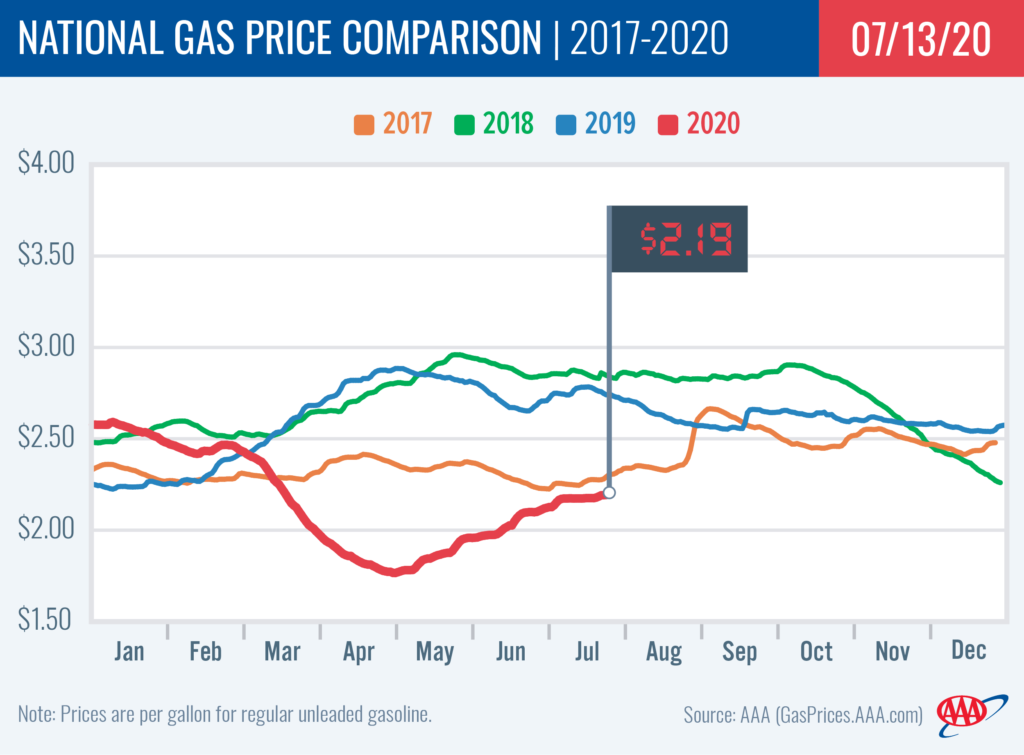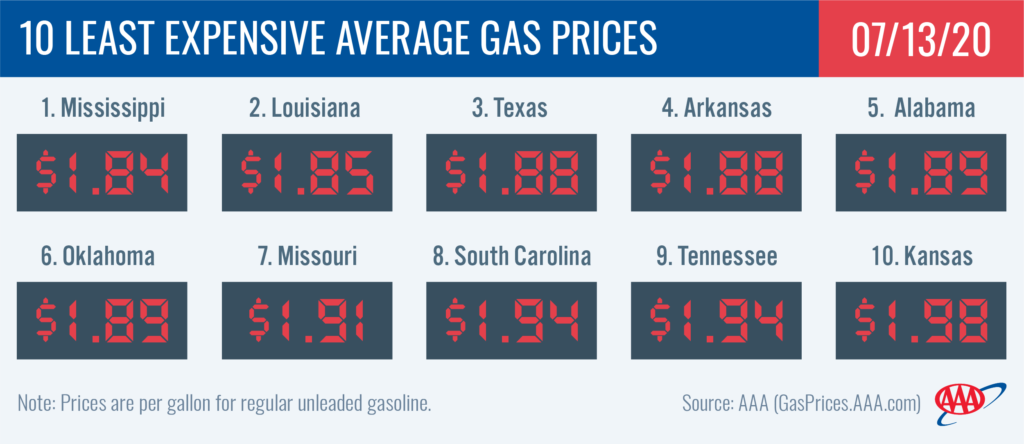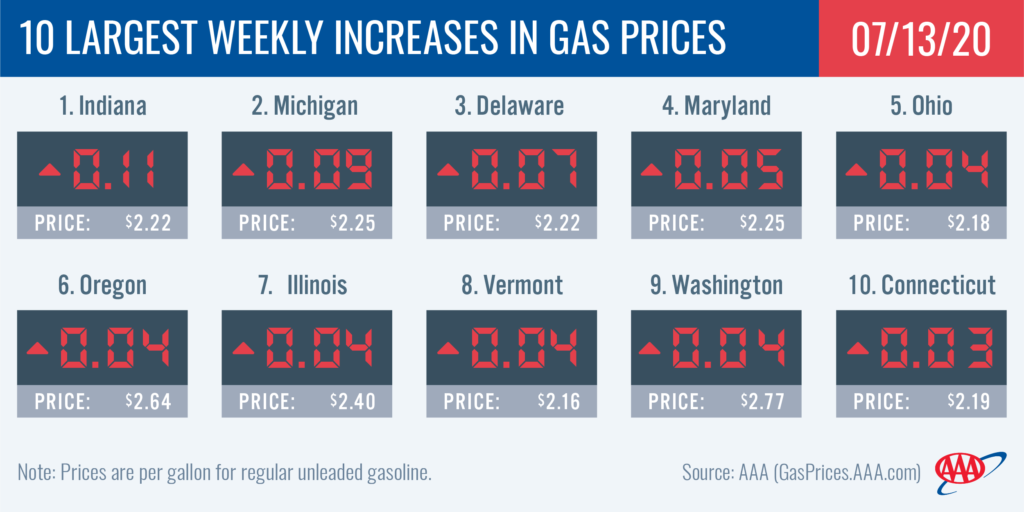LEXINGTON, Ky. (AAA/WTVQ) – Gas prices in Lexington and across Kentucky are down slightly as of Monday compared to last week.
That comes even as gasoline demand increased on the week to the highest level (8.7 million b/d) since March as stocks decreased, but the combination wasn’t enough to significantly impact gas price averages across the country, according to AAA. (For Kentucky stats, click AAA Gas Prices ).
On the week, the national gas price average only increased one penny to land at $2.19. That is nine cents more than last month and nearly 60 cents less than a year ago.
“The Energy Information Administration’s (EIA) data shows gasoline demand and supply continue on a roller coaster ride,” said Jeanette Casselano, AAA spokesperson. “As motorists react to unfolding COVID-19 information, we are seeing driving behaviors related to filling-up ebb and flow.”
From May to early July in 2019, gasoline demand averaged 9.5 million b/d. For the same time period this year, demand is measuring at 8 million b/d while gasoline stocks sit, on average, at a 24 million bbl surplus. The low demand and high supply are keeping gas prices relatively cheap for the summertime.

Quick Stats
- The nation’s top 10 largest weekly increases: Indiana (+11 cents), Michigan (+9 cents), Delaware (+7 cents), Maryland (+5 cents), Ohio (+4 cents), Oregon (+4 cents), Illinois (+4 cents), Vermont (+4 cents), Washington (+4 cents) and Connecticut (+3 cents).
- The nation’s top 10 least expensive markets: Mississippi ($1.84), Louisiana ($1.85), Texas ($1.88), Arkansas ($1.88), Alabama ($1.89), Oklahoma ($1.89), Missouri ($1.91), South Carolina ($1.94), Tennessee ($1.94)and Kansas ($1.98).

Mid-Atlantic and Northeast
Gas price fluctuation was low among the majority of Mid-Atlantic and Northeast states on the week. Delaware (+7 cent) and Maryland (+5 cents) saw the largest increases in the region and land on the top 10 list of states with the biggest changes, along with Connecticut (+4 cents) and Vermont (+3 cents). Washington, D.C. (-1 cent) and West Virginia (-2 cents) were among a minority of states in the country to see gas prices push cheaper.
The region saw stock levels plummet by nearly 3 million bbl. The EIA’s latest report measures total stock levels at 72.3 million bbl, which is still a healthy supply level for this time of year. While stocks could decrease further in the week ahead due to an unplanned shutdown at Phillips 66’s 265,000-b/d Bayway refinery in Linden, N.J., at the end of last week, this event has not had an immediate impact at the pump given the abnormally high level of stocks on hand.
Rockies
At $2.14, Wyoming carries the least expensive state gas price average among all Rockies states. Conversely, at $2.47, Colorado carries the most expensive gas price average, but, along with Idaho ($2.34) did not see gas prices increase on the week. Notably, Utah (-1 cent) saw a decrease while Wyoming (+3 cents) and Montana (+2 cents) saw the largest weekly increases.
Gasoline stocks built for a second week, according to EIA data. With a 100,000 bbl addition, total stocks sit at 7.5 million bbl – which is a typical measurement for summertime in the Rockies and will help to keep gas price volatility down in the weeks ahead, especially if demand stays relatively steady.
West Coast
Pump prices increased slowly last week in the West Coast region, and the trend is likely to continue this week. Washington and Oregon saw the largest increases in the region at +4 cents. Hawaii ($3.21) and California ($3.12) remain the most expensive markets in the country. Washington ($2.77), Nevada ($2.64), Oregon ($2.64), Alaska ($2.50) and Arizona ($2.33) follow.
According to EIA’s latest weekly report, total gas stocks in the region decreased from 30.3 million bbl to 29.6 million bbl last week. If demand increases, decreasing stocks will likely contribute to increasing pump prices in the region this week.
South and Southeast
South and Southeast state gas price averages saw minimal fluctuation on the week. South Carolina (+3 cents) saw the largest jump while Florida ($2.10) saw no change. All states in the region, with the exception of Florida and New Mexico ($2.02), have averages of $1.99 or below at the start of the work week. Georgia ($1.99) is likely to break the $2/gallon mark this week.
Stocks increased by nearly a half a million bbl to push closer to the 92 million bbl mark – which is about 10 million bbl more than this time last year. This extremely healthy supply of gasoline stocks will help to minimize fluctuation at the pump in weeks ahead.

Great Lakes and Central States
Indiana (+11 cents) and Michigan (+9 cents) had the highest gas price increases on the week in the country. Ohio (+4 cents) and Illinois (+4 cents) also land on the top 10 list for largest jump, though their increases are notably less. All other states in the region saw pump price increases of only a few cents, if at all.
Even with the increases, motorists in the region are paying 50 to 75 cents less a gallon to fill up compared to last July. Illinois (-76 cents), Indiana (-69 cents), Michigan (-69 cents) and Ohio (-68 cents) have among the largest year-over-year differences in the country.
With a 2 million bbl draw, the region saw stocks decrease for a third week in a row down to 50.6 million bbl. This drops total stock levels to not only the lowest measurement of the year, but the lowest since December 2019, according to EIA data. If stock levels continue to push lower, the region can expect to see incremental price changes at the pump.
Oil Market Dynamics
At the end of Friday’s formal trading session, WTI increased by 93 cents to settle at $40.55 per barrel. Domestic crude prices were volatile last week after EIA’s weekly report revealed that total domestic crude inventories increased by 5.7 million bbl to 539.2 million bbl. Increasing crude stocks could mean that crude production is still too high given where demand is currently, as new coronavirus outbreaks emerge. If EIA’s data shows another increase in total domestic supply this week, crude prices could decline.
"gas" - Google News
July 13, 2020 at 09:58PM
https://ift.tt/38Q61s2
Demand increases but gas prices edge downward - ABC 36 News - WTVQ
"gas" - Google News
https://ift.tt/2LxAFvS
https://ift.tt/3fcD5NP
Bagikan Berita Ini
















0 Response to "Demand increases but gas prices edge downward - ABC 36 News - WTVQ"
Post a Comment